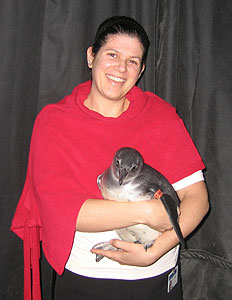 When a contest to name our newest penguin at the Steinhart Aquarium came around, I was more than excited. The prize after all was a picture with the chick and a rare opportunity to get close to an African penguin. My strategy for the contest was simple – submit 25 entries. Lo and behold, a few weeks later one of the judges asked me about one of my submissions – Safara. The name which means Fire in the Wolof language was deemed a perfect fit to dub the spirited chick.
When a contest to name our newest penguin at the Steinhart Aquarium came around, I was more than excited. The prize after all was a picture with the chick and a rare opportunity to get close to an African penguin. My strategy for the contest was simple – submit 25 entries. Lo and behold, a few weeks later one of the judges asked me about one of my submissions – Safara. The name which means Fire in the Wolof language was deemed a perfect fit to dub the spirited chick.
I met Safara in the back of the penguin enclosure a few days later. She was walking around in her pen with her brother Dunker close at hand. Both birds resembled full grown penguins in girth, however, their markings belied their younger age. While adults penguins are full black and white, chicks have lighter coloration. My heart was beating hard when Pam, our penguin caretaker, prepped me for the encounter. I picked Safara up nervously and placed her, with Pam's help, so that her feet rested on one forearm while I folded her against me with the other arm. Once she had solid footing, she settled in and took everything in stride. Pam explained to me that penguins like support for their feet while being held. I also learned how their heat escapes their body. Safara’s feet were hot against my skin! The sensation of her webbed feet and silken feathers was fascinating. Much of the time, I forgot to look at the camera because I was so taken with holding her!
Safara has been the only female chick born at 875 Howard Street. However, over the past few months, the Academy's African penguin colony has grown from eight to 13 birds. The Steinhart Aquarium is involved with a nationwide program-- the Species Survival Plan-- that facilitates the trade of captive bred penguins between zoos and aquariums in order to minimize taking birds from their natural habitat in Africa for display purposes. Howard, named after our building, is the first of the brood and is known for his booming voice. Dunker, named after the Aquarium Veterinarian, is the second eldest. Domino, who was named by an Academy member, was born shortly after Safara. All of these penguins now reside in the penguin tank and can be recognized by their exuberance and orange wing bands. Our newest chic, who is yet to be named is still being hand raised behind the scenes. When it is large enough, it will join the other youngsters in the penguin tank. All the penguins will eventually reside at the end of African Hall in the new Academy. The penguins are an iconic part of the Steinhart Aquarium and fuel many questions. Answers to frequently asked questions can be found at http://www.calacademy.org/aquarium/penguin_facts.php. I know my curiosity was piqued after meeting Safara, up close and personal.
![]() Cat Aboudara is the Special Projects Manager at California Academy of Sciences and works in the public programs division. The Academy is a wonderful fit for her because of her curiosity about the natural world and her experience in working with native California wildlife.
Cat Aboudara is the Special Projects Manager at California Academy of Sciences and works in the public programs division. The Academy is a wonderful fit for her because of her curiosity about the natural world and her experience in working with native California wildlife.
